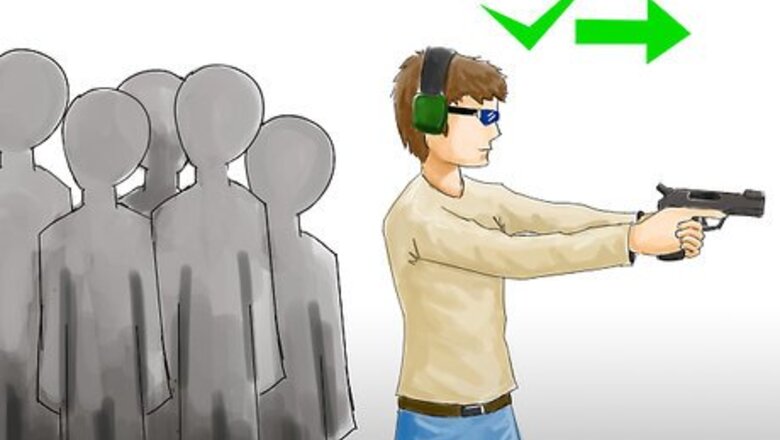
views
The following rules are generally in order of priority (highest to lowest), but they are all very important and should be followed at all times. Safe firearms handling techniques should be done consistently each and every time: being 99% safe is a recipe for tragedy when it comes to firearms.
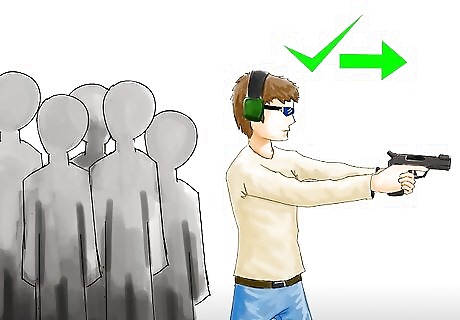
Always keep the muzzle pointed in a safe direction. This rule surpasses all other rules. It is a very simple concept, if the firearm is pointed in a safe direction, intentional or accidental discharge will not harm anyone. The safest direction should be chosen, so humans, animals, then inanimate objects are all taken into account. This also includes being sure that when you carry the firearm you are able to fully control the muzzle direction and angle, especially if you are walking, or otherwise traveling (in case you trip or stumble, this is also helped by Rule 3).
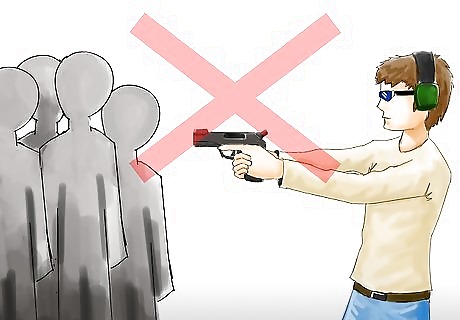
Assume that the firearm is always loaded. Even if the firearm is known to be unloaded, it should be treated with the respect of a loaded gun. For example, even though you've just triple checked and know it is unloaded, you still don’t point it at people (follow Rule 1 at all times).

Keep your finger off the trigger. This prevents any accidental discharges from a trigger pull. With a pistol, there is usually an area above the trigger where you can rest your trigger finger (they often call this the "index point"). For rifles or other guns, it is best to remove your whole hand from the area where the trigger is. There are plenty of other safe ways to carry the gun. Along with this, it should be emphasized to not rely on the firearm's safety. While human error is many times more likely to cause a problem, the safety can fail, and pulling the trigger may result in an accidental discharge. Certain pistols don't have manual safeties at all. In this case, they often have safeties integrated into the trigger, back strap (or grip), or hammer. These types of guns are especially dangerous around inexperienced users. But training and aggressive execution of safety techniques can overcome many of the dangers of a safety-less firearm. Once you are on the line to shoot, do not put your finger on the trigger until you have pointed in on the target. This may be a difficult habit to break as you may feel it is natural to have your finger on the trigger once you think you are wanting to shoot.
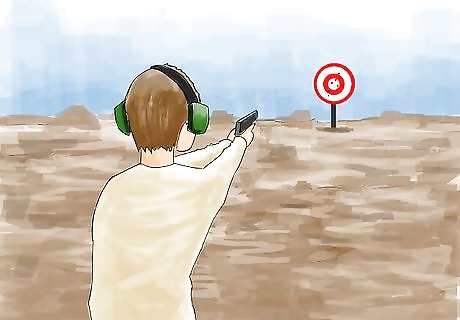
Be sure of your target and everything that is downrange. This is important. Now that you have reached the point where you can fire, you want to be absolutely sure of what your target is, and what is behind it. In many cases the bullet fired can go through the target and out the other side. Anything downrange is important to watch. Bullets may strike an intended or unintended target and bounce, ricochet, or otherwise change direction. Be sure, if you are shooting with others around, that you do not stand behind anyone when you fire. Not only is this unsafe, but it is discourteous. Anyone shooting should be side by side. This prevents accidental shootings, it also prevents someone from being startled by the muzzle blast from the firearm. Even small guns like a .22 LR pistol can put out a blast to make a grown man jump. And anything in front or to the sides of the muzzle can feel it. Larger caliber firearms can actually cause headaches or damage just from the muzzle blast.
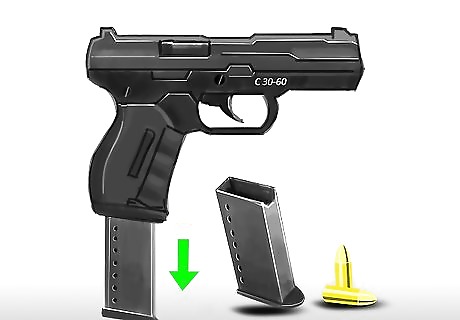
Always hand a firearm to someone unloaded. If you hand a firearm to someone it should be unloaded. Check the magazine and the chamber. When the firearm is not going to be used immediately, it should be unloaded in the same manner. If you receive a firearm from someone, you should check the magazine and chamber to make sure the gun is not loaded, until you intend to fire. A good way to let yourself, and anyone around you, know the gun is unloaded is by locking the bolt, slide, or cylinder in the open position. This makes it so that, even if the trigger is pulled, no bullet will fire. Check the manual for the firearm. It will generally mention the safest way to carry or unload the firearm. When not using the firearm or while transporting it, you should always unload the firearm. In many locales, there are laws against carrying a loaded firearm in a vehicle without the proper permits, even if just transporting it to and from a firing range or repair shop.
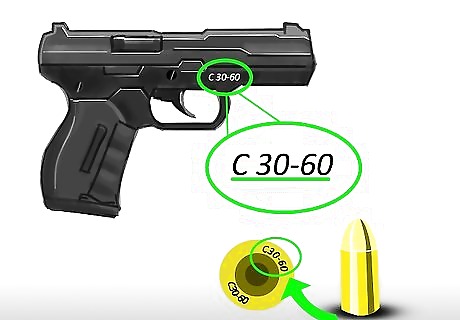
Use the proper ammunition. Using improper ammunition for your firearm can not only damage or destroy your firearm, but can also cause serious injury or even death. The firearm is specifically designed for one specific caliber or gauge and possibly even a specific load of ammunition. Overly-reloaded or improperly hand-loaded cartridges or shells can be a danger and detriment to the firearm, the shooter, and others around the firearm. An improper detonation in a firearm which disables the firearm is known by many as a "kaBoom" or "kB!" for short. For example: though a .40 S&W caliber cartridge may load into a .45 ACP magazine, placing the smaller round into the gun makes the unsupported casing blow out of the gun, or blow apart throwing shrapnel from the gun. Some pistols are known to have kB!s from reloaded or hand loaded ammunition. A couple of common guns are the M1911 and Glocks in .40 S&W (both are known to do it with "hot", over loaded ammunition). These failures are due to the internal design of the weapons and cannot be compensated for. Manufactured ammunition is usually best. They have tested the loads and pressures many times with expensive machines. They invariably put out the most consistent loadings. In general, the more expensive ammunition is more consistent, but that is not always the case. Match-grade ammunition is specifically measured and engineered to be as consistent as possible. It is also usually the most expensive ammunition. Powder loads are also important to pay attention to. Both 9x19mm (9mm Luger Parabellum) and .45 ACP (and other cartridges) have rounds known as "TAP" or other nicknames by companies, these are known as "hot" rounds. They have extra powder which results in higher chamber pressures. The next step up is "+P", and 9x19mm cartridges can also come in "+P+". Each step up causes greater chamber pressures which also results in higher muzzle velocities for the rounds. But many pistols are unable to shoot "+P" reliably, without damaging parts. Dual-stage recoil springs are a good indicator that a pistol is able to shoot the "hot" loads without a problem, but asking the manufacturer and checking the manual is the best way to ensure you are not damaging your weapon or putting yourself at risk. For rifles such as the .223 Remington, there are additional considerations as well. The 5.56x45mm NATO rounds are the exact same dimensions as the .223 Remington rounds. However, the general rule of thumb is this: if the weapon is advertised as a .223, do not fire 5.56x45mm ammunition through it. There are different types or receiver/chamber specifications. Most .223 rifles have the SAAMI-spec chamber which is not the same as the Mil-Spec chamber, as would be on an M16 or other military-type rifles. The SAAMI is designed to be highly accurate, but not as durable as the Mil-Spec, which gives up tolerances for pressure resistance and reliability. Mil-Spec chambers are able to shoot .223 rounds fine (though less accurately), but NOT vice versa. The .308 Winchester and the 7.62x51mm NATO rounds are the same. So no precautions are needed in this case.

Wear ear and eye protection. For many small caliber rifles ear protection is not completely necessary, but it is highly recommended. While the sound from small caliber fire may not cause pain, it still has a potential to damage your hearing. When shooting anything larger than a .22 LR, it is strongly suggested that you use ear protection, especially during extended use. Ringing in your ears after a shot is fired is a sign that your ears are exceeding their percussive limitations and possibly causing permanent damage. Eye protection is a must. Even though you may be confident that there are no problems with your firearm, small problems can arise from your firearm heating up from firing, or from ammunition defects. There is also the problem of flying brass (spent cartridges) hitting you in the eye. Another problem usually presents itself with larger calibers or pistols with very short (less than three inch) barrels; there may be unburned powder flying through the air, or even bouncing off the back of the bullet just fired, which can then be0 redirected toward you.
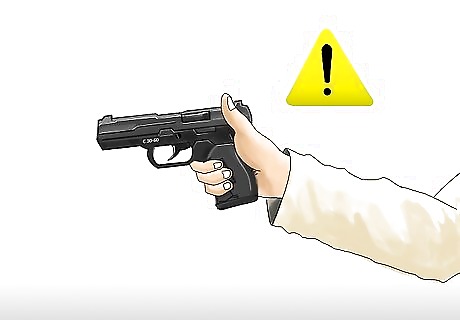
If your gun doesn’t fire when the trigger is pulled, be cautious. When the trigger is pulled, and there is no "boom," think to make sure you had a round in the chamber. If you are absolutely sure you did not have one in the chamber, fix the problem. If you think there was a cartridge in the chamber, hold the gun, pointed toward the target. You can try firing the gun again (if it is a double-action gun), try this once, maybe twice, and if nothing happens still, keep the gun pointed at the target for about 20 seconds. If the round still does not fire, carefully remove the magazine (if possible) and eject the round out of the chamber. Place the dud cartridge in a safe area (away from humans, valuables or other ammunition). The problem is usually due to a dud primer, and is much more common in hand-loaded ammunition than manufactured ammunition (see rule 6).

Be sure the firearm's barrel, chamber, and action are clear of obstruction before firing. Anything caught in the barrel can cause major damage to your barrel and/or firearm; it can even cause a kB! Obstructions in the chamber can cause the round not to load properly, or not load at all. It can also cause extraction and ejection problems which drastically reduce the reliability of the gun. An action impediment can prevent the hammer of the firearm from hitting the round (or firing pin) or prevent it from drawing again to fire another round.

Maintain your firearm properly. Maintenance is a big concern when owning a firearm. The older the firearm the more important it can become. In general, the firearm should be cleaned after each use. Some firearm manufacturers recommend the wearing of eye protection prior to field stripping the weapon. This may help prevent any eye injuries resulting from inadvertently "launching" springs or other components when field stripping the weapon. Pistols should be, at minimum, "field stripped" (if possible), cleaned with a cloth and/or brush and solvent. The barrel should be brushed out with a barrel brush. There will likely be a lot of carbon and powder build up in the chamber, so a pick and more solvent can be used there. Once that is done, wipe again with a clean cloth (to remove all solvent). Each moving part should be lubricated with gun oil (except the firing pin of semi-auto pistols which can become gummed up with grime and carbon collected by the oil). The exterior of the barrel and the slide rail guides especially (on the slide and the frame) should also be lubricated. Using too much oil, though, may encourage powder and carbon buildup in those areas. Once done, wipe the externals down with a clean cloth to remove any excess oil and pull the slide back a few times to work some of the oil around. Field stripping rifles and shotguns for cleaning are usually a bit more difficult or complex. Alternatively, a brush with solvent can be used to clean the action and chamber without much, or any, dismantling. Wipe as much down with a clean cloth as possible. Use barrel solvent to clean the barrel best, or a bore snake can work very well too. Oil the trigger assembly (according to the manual), and oil, with gun oil, the bolt and action. Pull the bolt back and forth a few times to work the oil in. Wipe any excess oil off with a clean cloth. If the firearm is not to be fired for a significant amount of time, it is best to do a very thorough cleaning before storage. There are products on the market designed to protect your firearm for many years (decades if needed), but these are not recommended for storage over only a few years (or less). It is best to properly clean, then oil your firearm (maybe over-oil the firearm). Every 6-8 months, the firearm should be taken out and oiled again (maybe cleaned too if there is dust build up). With plenty of oil and a good initial cleaning, the firearm should stay in perfect condition. Storage in a dry area would help too, but the oil should displace and protect against moisture on your firearm. After not using the firearm for an extended period of time, it is best to clean and re-oil it before use.
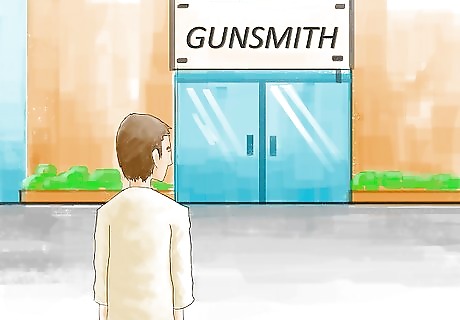
Proper modification of the firearm. While many recommend not modifying your firearm (this has the greatest chance of keeping your warranty and your firearm reliable), it can be done in a proper way. It is generally best to let the factory do all your modifications, but this is not always possible. A certified gunsmith with your firearm's1 manufacturer's certification would be the next best choice. If you do not have many gunsmiths in your area or none of them are certified by the manufacturer of your firearm, it is probably best not to have your firearm modified. Never do any modification yourself. Changes to your firearm which are done improperly could permanently damage the firearm, and can cause problems such as a kB! when fired.

Learn the safety and firing characteristics of the firearm. Learning how to use a firearm safely is paramount. Learn how to unload the magazine (if available), unload and check the chamber, engage the safety (if available), clear jams, examine the barrel, and field strip (if available) the firearm. Firing characteristics are also a key component of knowing the firearm you are using. If you are unaware about certain aspects of the gun such as the amount of kick from a firearm, ask someone who is knowledgeable with that specific firearm. Be sure you are able to consistently operate the firearm safely.

Never shoot hard or flat surfaces (including water). While some objects may seem tantalizing to shoot, many metallic or other hard and/or flat objects can be very dangerous to shoot. These objects, including water, can cause the bullet to bounce or ricochet in unexpected and dangerous directions. They are even able to bounce back toward or near the shooter. Smaller, low velocity bullets (such as the .22 LR) are very well known for their ability to ricochet. Due to their light weight and low velocity, things like wood, rocks, or even dirt can cause the bullet to ricochet. Refer to Rule 4. One piece of good news about ricochets is the fact that (in general) bullets do not bounce (as a ball would), because of the extreme velocities (of even low velocity bullets) and because the soft lead bullets tend to follow relatively parallel paths to the plane of the object that has been hit. Thus, where the shooter is standing, is usually the safest place to be when a ricochet occurs. There are exceptions to this, such as solid core bullets (no lead core) which change the dynamics of the bullet, rubber can cause a bullet to bounce straight back, and hard objects which are angled can cause the bullet to wrap around back toward the shooter.
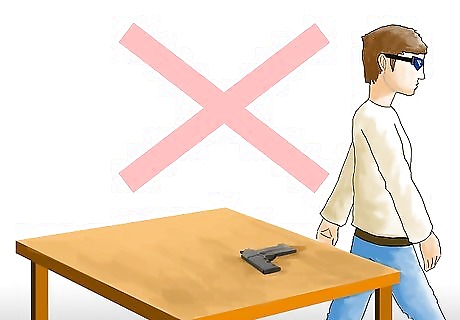
Never allow your loaded firearm out of your control. If you have a loaded firearm, never leave it unattended. This is while at the range and your home. If you can't be certain of its status or who may have access to it, it is best to unload the firearm, lock the firearm with a slide lock (for a pistol) or lock the firearm in a hard case or a safe. For optimal safety, keep the ammunition in a separate area, locked up as well. Be sure to follow all state and local laws regarding firearm storage. Some states do not require firearms to be locked away, but keep in mind that there are children or others who may obtain access to your firearms or ammunition.
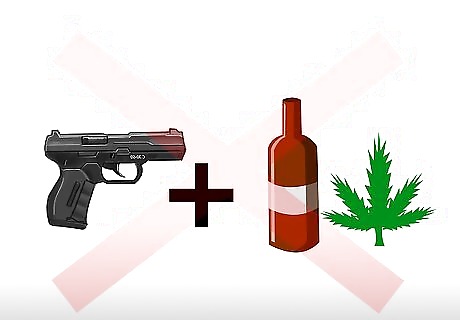
Never mix alcohol or drugs with firearms. Even the slightest bit of alcohol or drugs (even prescription drugs) can impair or alter your judgment of even common or simple things. This combination can be a lethal dose to yourself or others around you when involving firearms. Never, under any circumstances, use a firearm while not completely sober.



















Comments
0 comment